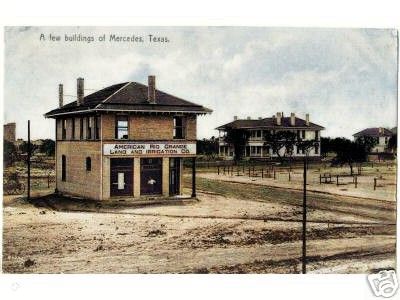 A111
The First American Rio Grande Land & Irrigation Building 1907
A111
The First American Rio Grande Land & Irrigation Building 1907
Very early postcard picture of the American Rio Grande Land and Irrigation (ARGL) Company offices, one of the first buildings in Mercedes. The unpaved road on the right later became Texas Avenue, and the building in the middle is the Mercedes Hotel. On the far right ARGL company home. Investors formed the American Rio Grande Land and Irrigation Company in 1905 to build the canal system and develop agricultural land. It became the largest irrigation company in the Valley. The original office building seen here was was replaced by the one that still stands today at 2nd and Illinois Streets.
View Enlarged
View Source Article
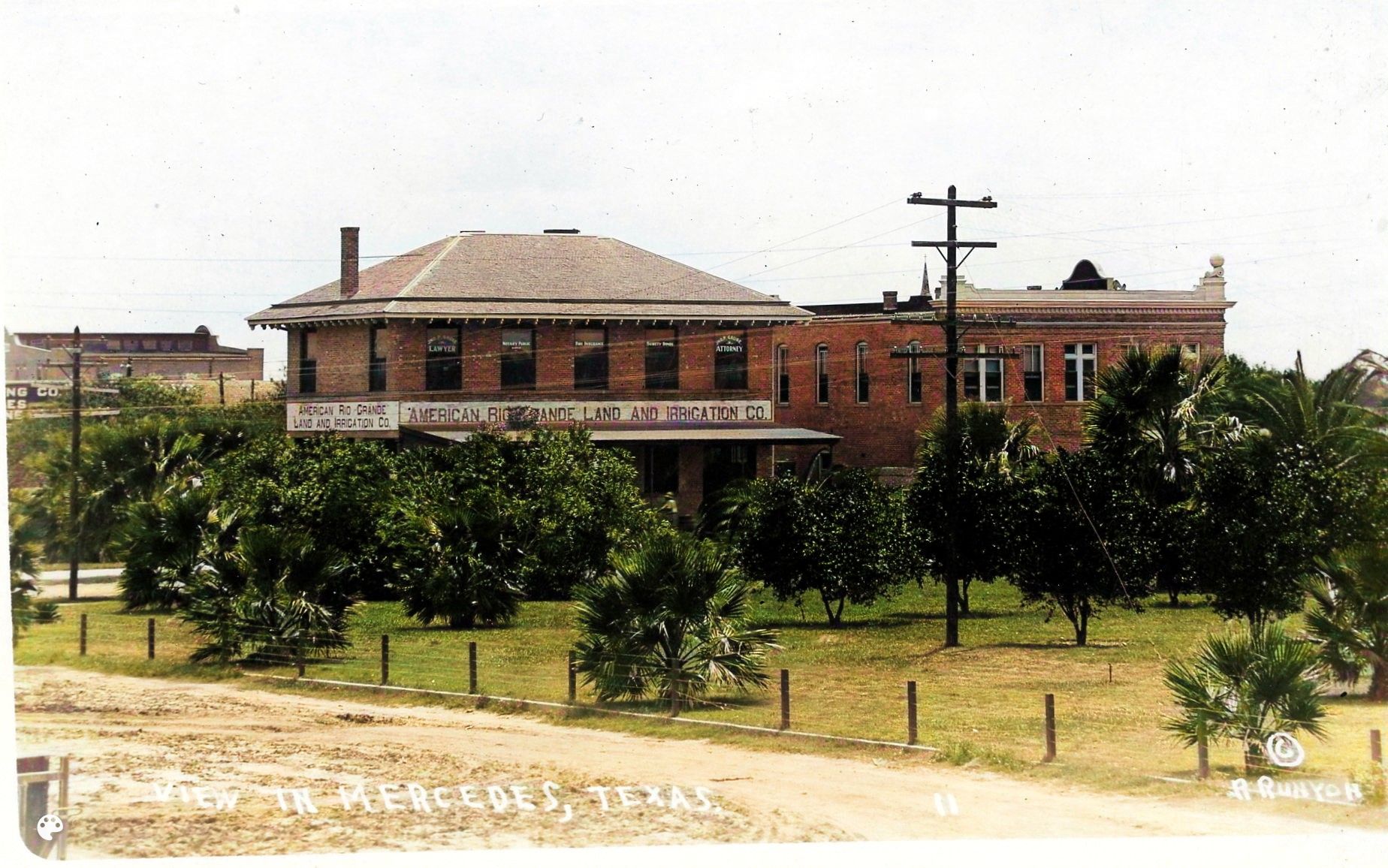 R007
Later View of Original American Rio Grande Land & Irrigation Building 1909
R007
Later View of Original American Rio Grande Land & Irrigation Building 1909
This is a later view of the original American Rio Grande Land and Irrigation building, as seen from the north looking south. The Hotel Mercedes Annex building has been built next door, and the Mercedes Power Station is located in the distant left. A cluster of native Sabal Palms is in the foreground.
View Enlarged
View Library
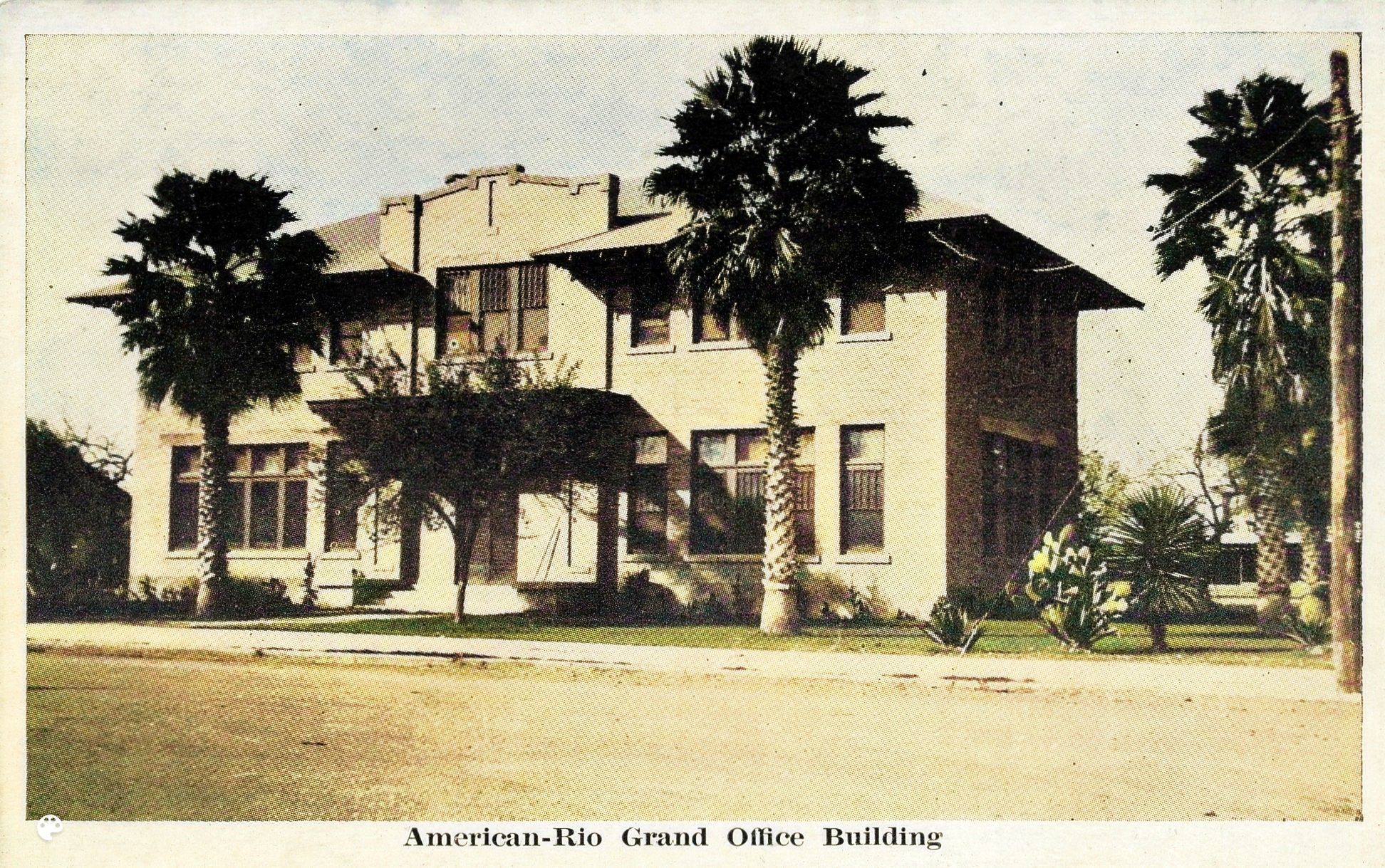 D002
Original American-Rio Grande Irrigation Building 1920
D002
Original American-Rio Grande Irrigation Building 1920
This building was built in Mercedes around 1920 at the Northwest corner of Ohio and 2nd Streets. It replaced the original red brick American Rio Grande Land and Irrigation Company. In 1927, management of irrigation was transferred to Hidalgo and Cameron County Irrigation District 9, and the building became their office.
View Enlarged
View Source Article
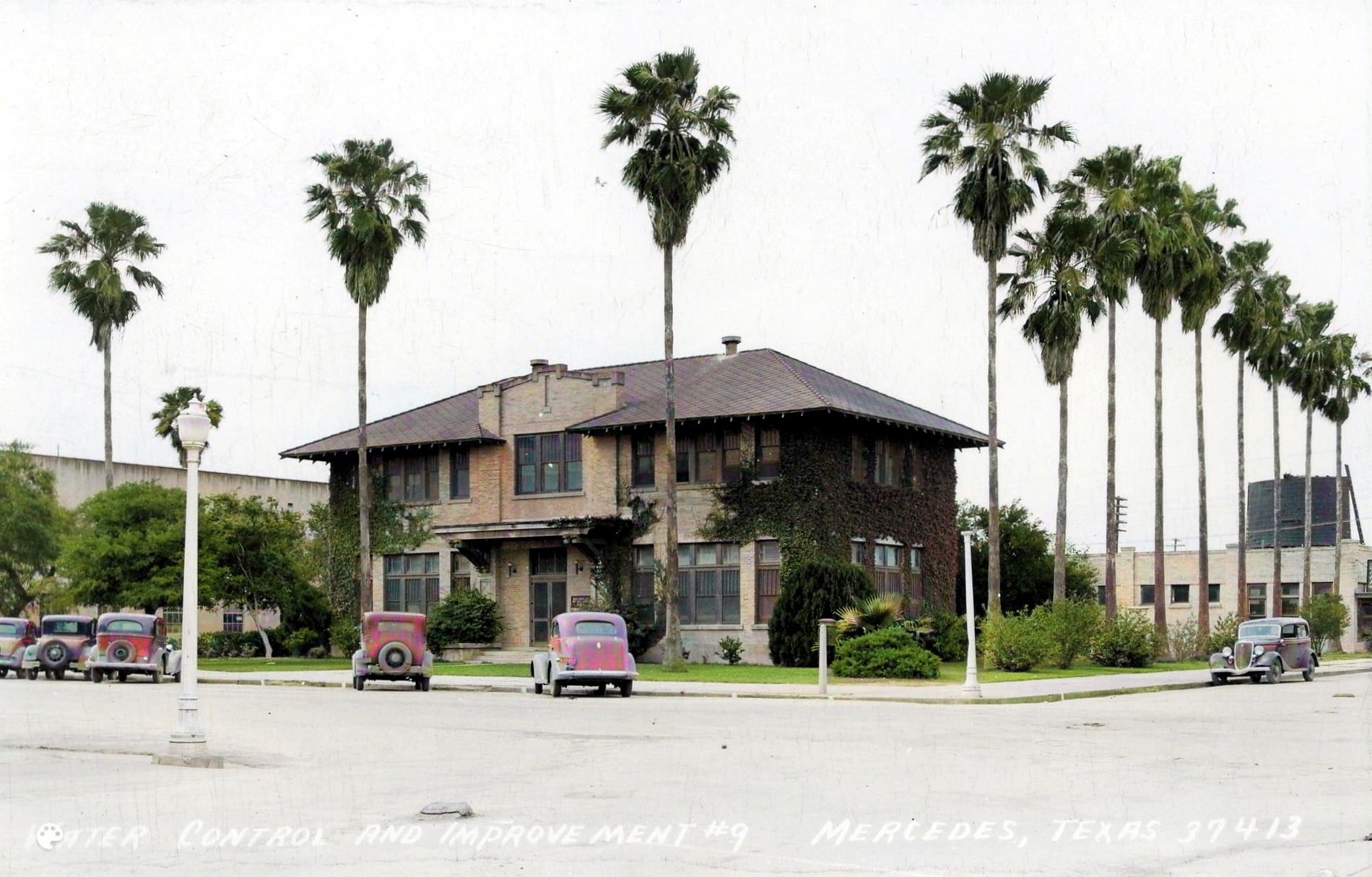 L005
Later View of Relocated American Rio Grande Land and Irrigation Building 1940
L005
Later View of Relocated American Rio Grande Land and Irrigation Building 1940
In 2009, Hidalgo and Cameron Counties Irrigation District 9 relocated its offices to FM Road 491, vacating this historic structure after 80 years of use. It remains standing and hopefully will be restored and repurposed one day. The front parapet pays homage to Mission Revival design, although the red brick building lacks other features characteristic of the style, such as stucco and arches.
View Enlarged
View Source Article
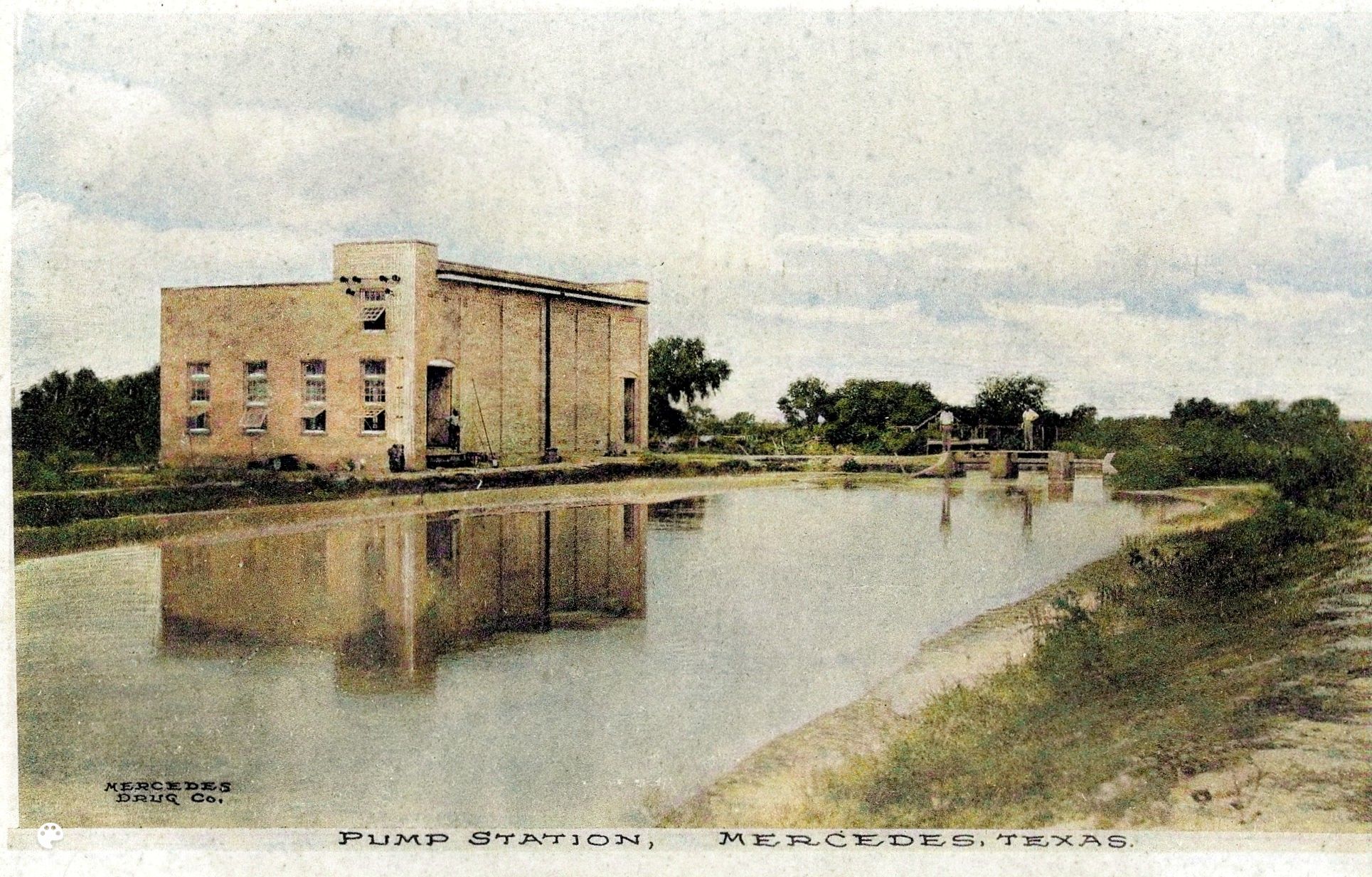 E006
Mercedes Irrigation Pump Station Was Vanguard of Technology 1912
E006
Mercedes Irrigation Pump Station Was Vanguard of Technology 1912
In the early 1900s, coal-fired steam powered all irrigation pumps in the Rio Grande Valley. The first irrigation pump station powered by electricity in the valley was built in Mercedes and began operations in 1908. The electrical power was transmitted from the Mercedes Power Plant located eight miles to the north in the town.
The pumps at the Mercedes irrigation pump station measured 36 inches in diameter, the largest in the world at that time. They pumped 300 thousand gallons of water per minute from the Rio Grande River into the Mercedes Main Canal. [24]
View Enlarged
View Library
 E007
Mercedes Irrigation Pump Plant, View of Outlet from Main Pump 1912
E007
Mercedes Irrigation Pump Plant, View of Outlet from Main Pump 1912
This postcard shows water flowing from the outlet of the Mercedes Irrigation Pump Plant station and entering the Mercedes Main Canal. From there the water flows North by gravity to provide agricultural irrigation water for farms and citrus orchards. By 1920, the Mercedes irrigation system had grown to three major canals and many miles of canal branches. [6] The American Rio Grande Irrigation & Land Company built the Mercedes Power Plant, the Irrigation Pump Plant and the entire canal system in the Mercedes area. [24]
View Enlarged
View Library
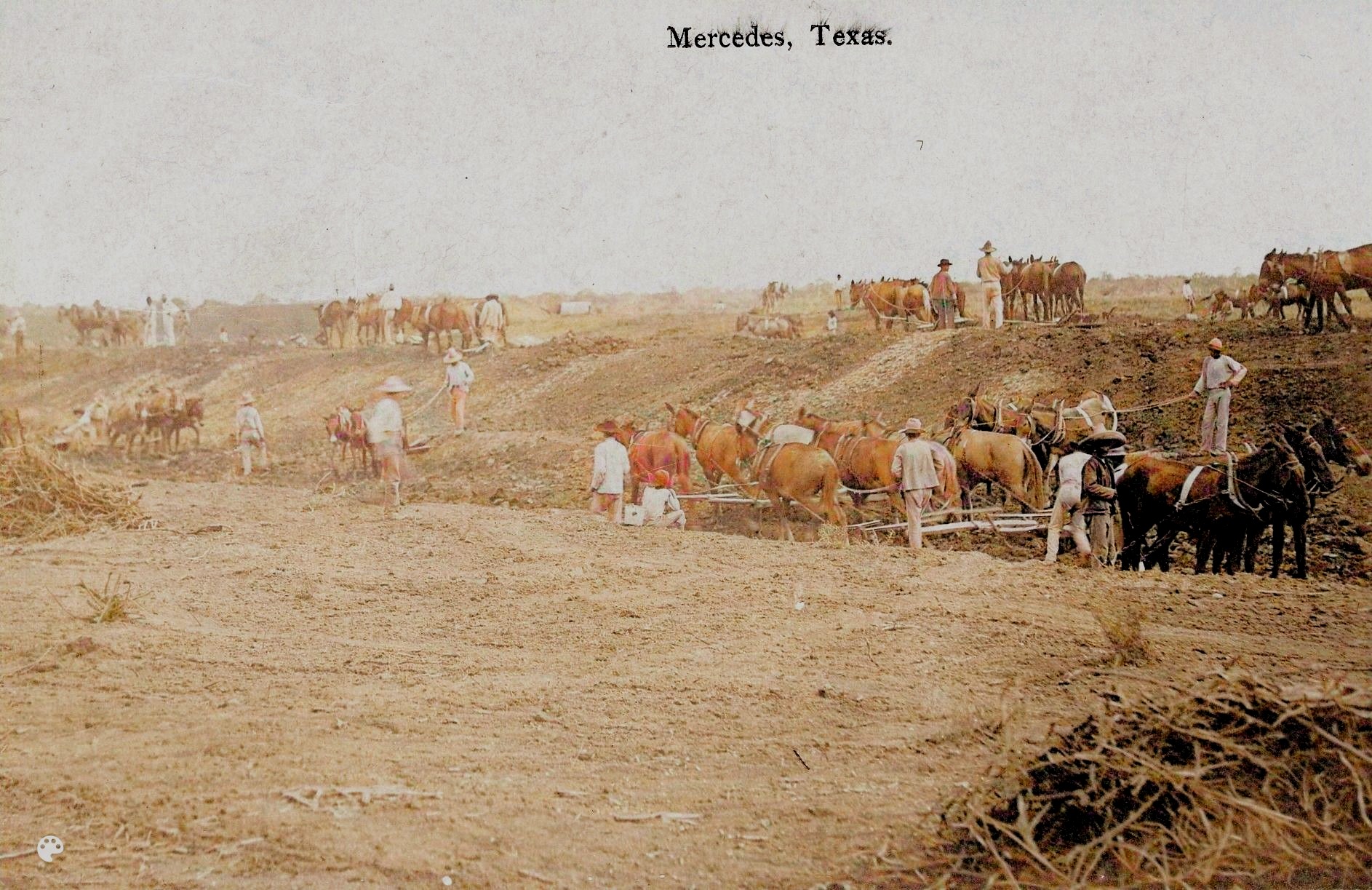 B004
Dredging the Mercedes Main Canal 1906
B004
Dredging the Mercedes Main Canal 1906
On May 1, 1906, the American Rio Grande Irrigation and Land Company began dredging the Mercedes Main Canal. It took over five hundred men and three hundred mule teams to carve the canal from a stretch of land seven miles long between the Rio Grande River and the Mercedes Electric Power Station. [24]
According to an article published by the Development Corporation of Mercedes, 'The hard and back-breaking work of laborers who cleared the brush, dug the canals and its branches, made the drawings of the engineers come to life and form the basis of what for over 50 years would define the economy of Mercedes and the Rio Grande Valley.' [8]
View Enlarged
View Library
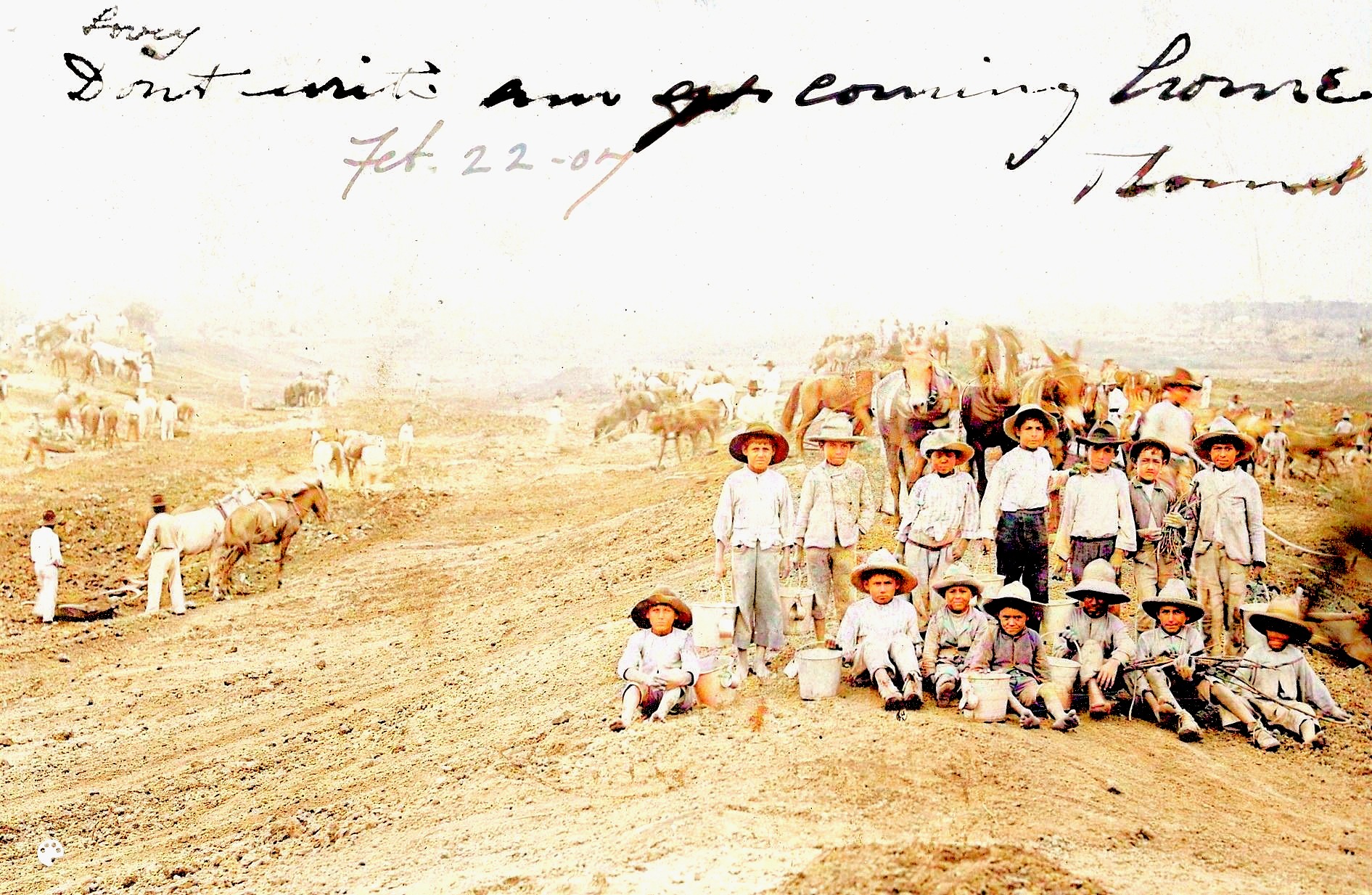 B005
Children Working on Mercedes Main Canal Dredging 1906
B005
Children Working on Mercedes Main Canal Dredging 1906
There were no child labor laws in the early part of the century. Many children worked on the Meredes canal dredging project. Here a group of children pose, some barefoot, with their buckets and crude tools in front of a mule team. Today in 2023, the Mercedes canal system continues to supply local irrigation water for farms and orchards, a testament to these children and others who labored to build it over a century ago.
View Enlarged
View Library
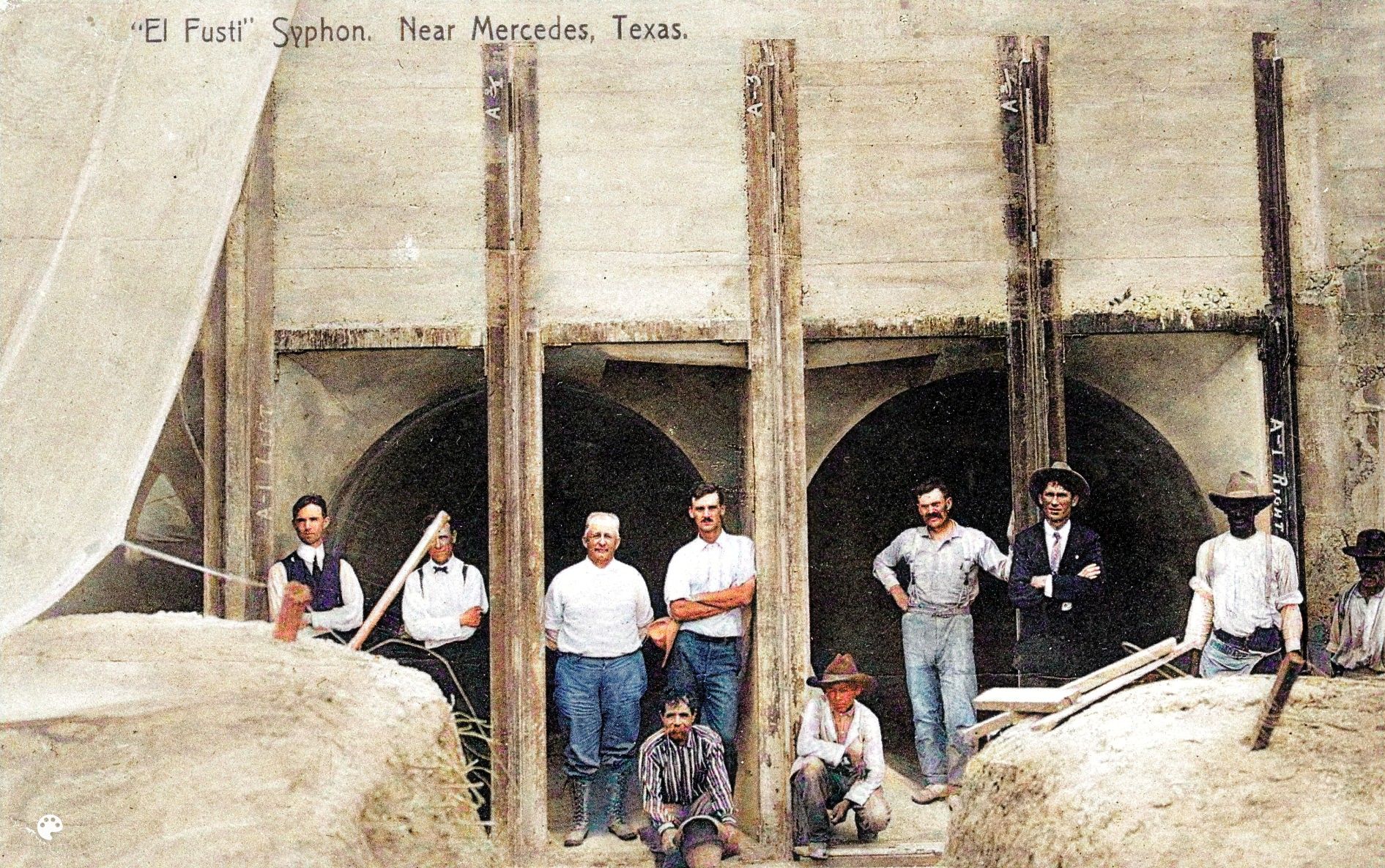 J001
Engineers Constructed a Syphon Shaped Conduit Under the El Fusti Ravine 1907
J001
Engineers Constructed a Syphon Shaped Conduit Under the El Fusti Ravine 1907
Building the El Fusti Syphon was the most difficult engineering challenge of the Mercedes Main Canal irrigation project, which was financed by the American Rio Grande Land and Irrigation Company. In this postcard image, engineers and workers stand proudly in front of the El Fusti Syphon. During the rainy season, the El Fusti Ravine was the main drainage artery into the Arroyo Colorado for the Mercedes area. Building the Main Canal across the ravine would have interfered with this drainage.
The engineers designed and constructed a concrete conduit in the shape of an inverted siphon to channel the canal under the ravine. One of the first projects in Texas to utilize concrete, the El Fusti project was completed in 1914. the syphon consisted of a 42-foot-diameter, 1,200-foot-long concrete pipe embedded with wooden support beams. [22]
View Enlarged
View Library
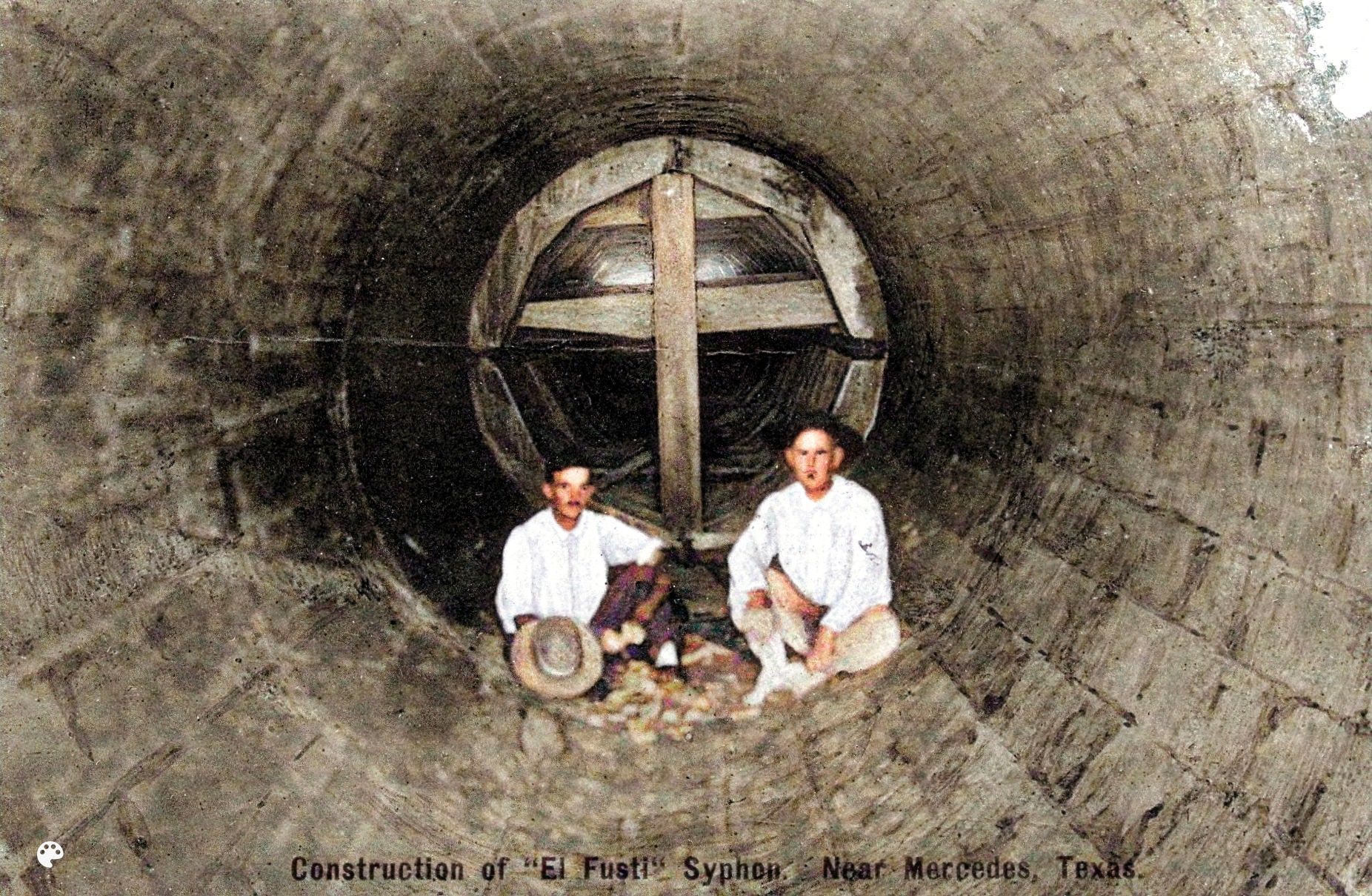 J002
Construction of the El Fusti Syphon Was An Engineering Challenge 1907
J002
Construction of the El Fusti Syphon Was An Engineering Challenge 1907
When completed, this El Fusti Syphon 'consisted of four pipes, each eight feet in diameter, leaving the canal by flood gates, south of the ravine, and dipping downward to avoid the bed of the ravine and rising again to practically the same level, enter the canal on the north side six hundred feet from the starting point.' [22]
The El Fusti Syphon was located south of Mercedes, just west of where the main canal passes through the Arroyo Colorodo. The name El Fusti originated with the Fusti Ranch, which was owned by hiers of Spanish land grantees Ynojosa de BallÃ. El Fusti was a ravine which drained the ranch and surrounding area into the Arroyo Colorado.
View Enlarged
View Library
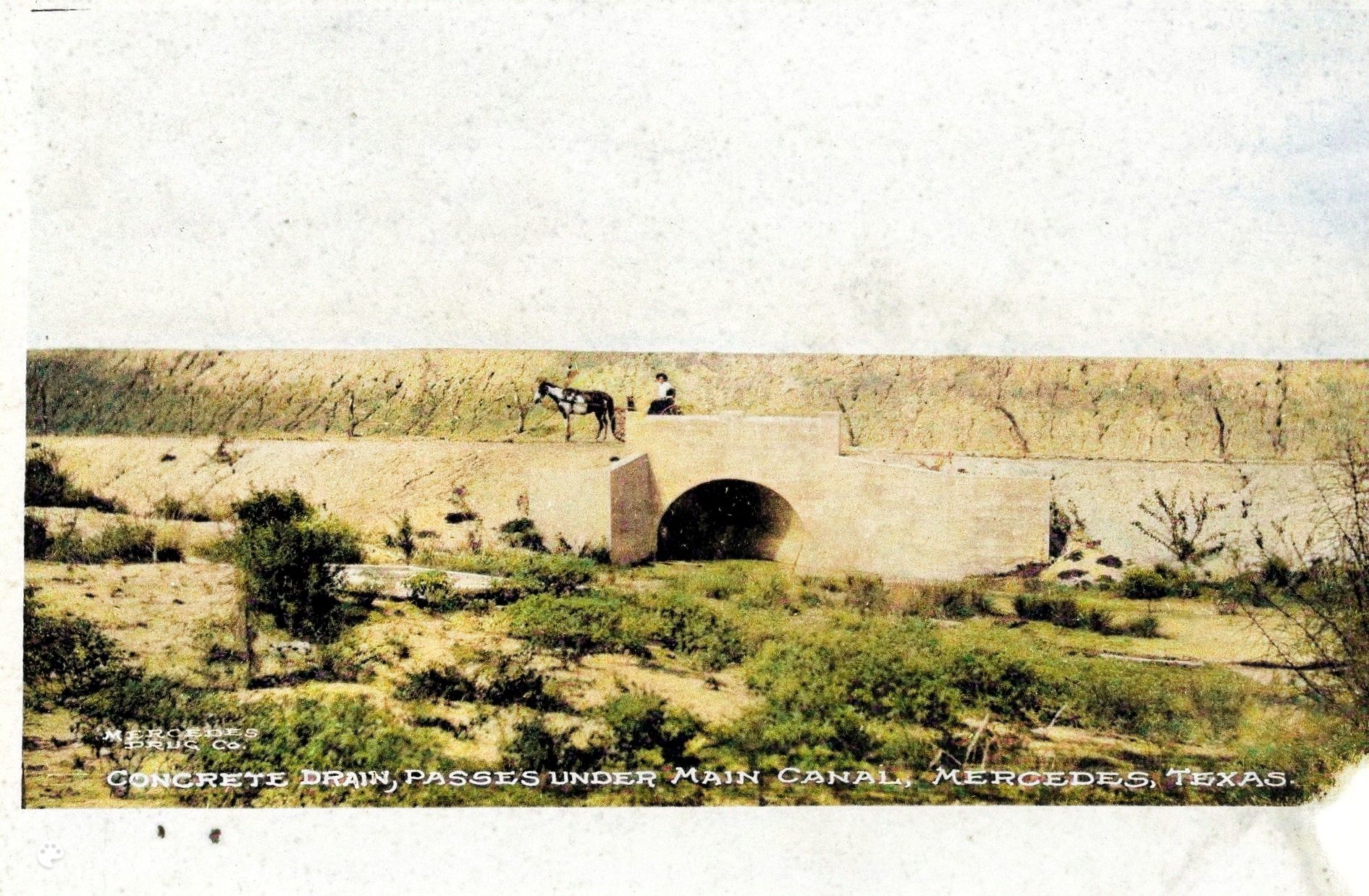 E002
El Fusti Syphon - Concrete Drain Under Mercedes Main Canal 1914
E002
El Fusti Syphon - Concrete Drain Under Mercedes Main Canal 1914
The American Irrigation and Land Company introduced the use of concrete in canal construction in the lower Rio Grande Valley. Concrete was a key technological advance in the construction of many canal components, including head gates, siphons, drains, and flumes. The use of concrete allowed for the construction of larger and more complex canals than would have been possible with other materials. This, in turn, allowed for the irrigation of more land and the production of more crops. The use of concrete also made the canals more durable, which reduced the need for maintenance and repairs. The introduction of concrete had a significant impact on the development of the lower Rio Grande Valley.
[24]
View Enlarged
View Library
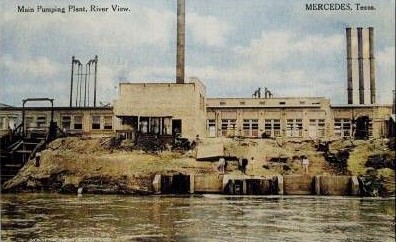 E105
Mercedes Irrigation Pump Plant, View from River 1912
E105
Mercedes Irrigation Pump Plant, View from River 1912
This postcard depicts the Mercedes Irrigation Pump Plant from across the Rio Grande River. The main water intake, located on the far left, lifed water from the river into the plant. The irrigation pump plant is still in operation today. The pumps installed in the early days have been replaced with modern ones, and the building has also been modernized. [24]
View Enlarged
View Source Article
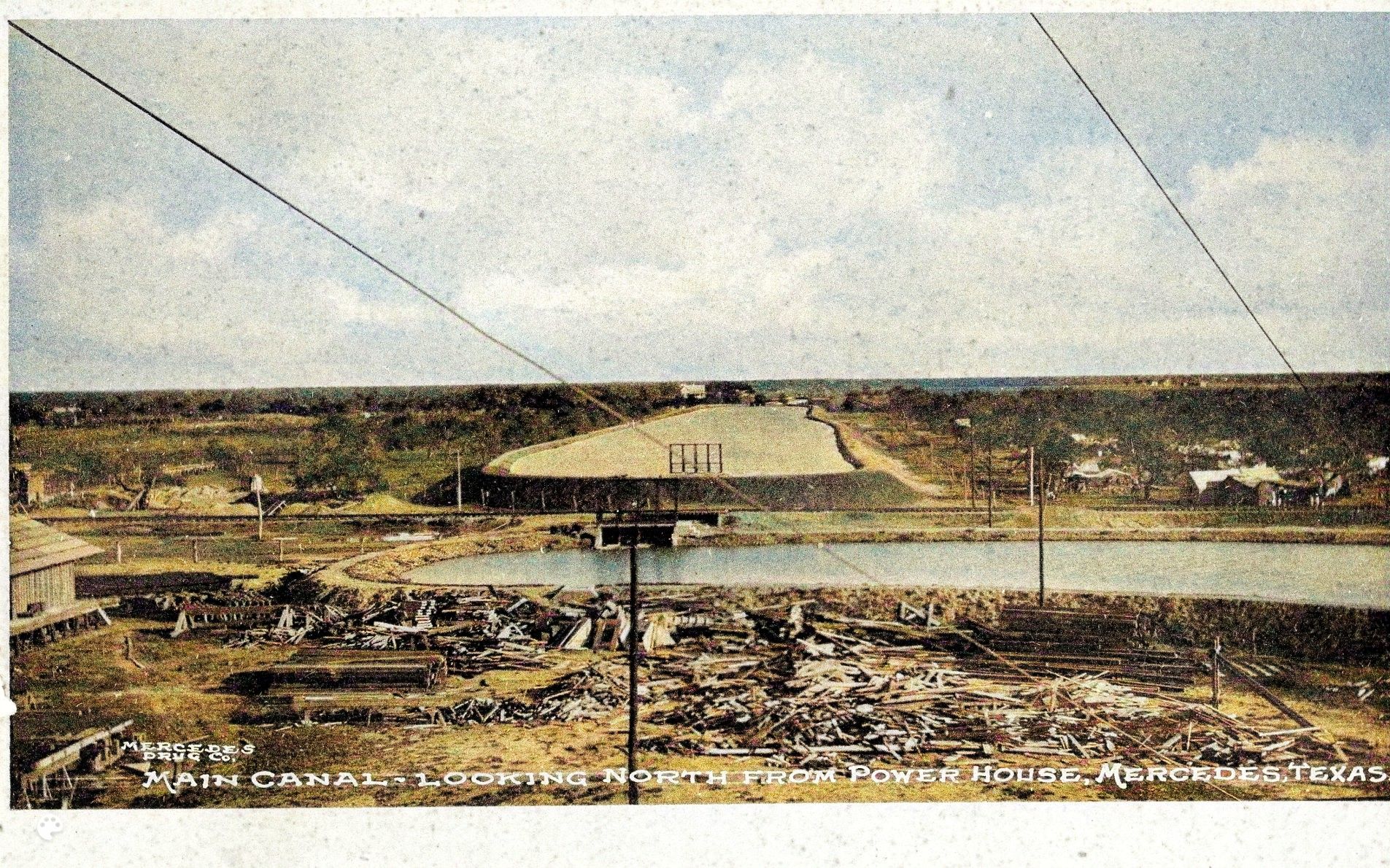 E003
Mercedes Main Canal Looking North from Power House 1914
E003
Mercedes Main Canal Looking North from Power House 1914
This image of the Mercedes Main Canal was taken from the Mercedes Power Station near the intersection of North Illinois and North Capisallo streets. Look closely to see the outlet channeling water under the railroad tracks. This layout has not changed much in over 100 years. The Electric Power Plant structure is still standing in Mercedes, but it is no longer in use. The Main Canal, on the other hand, is still in use, providing water for agriculture in the Mercedes area. It now extends north for about 14 miles from the Rio Grande River.[24]
View Enlarged
View Library
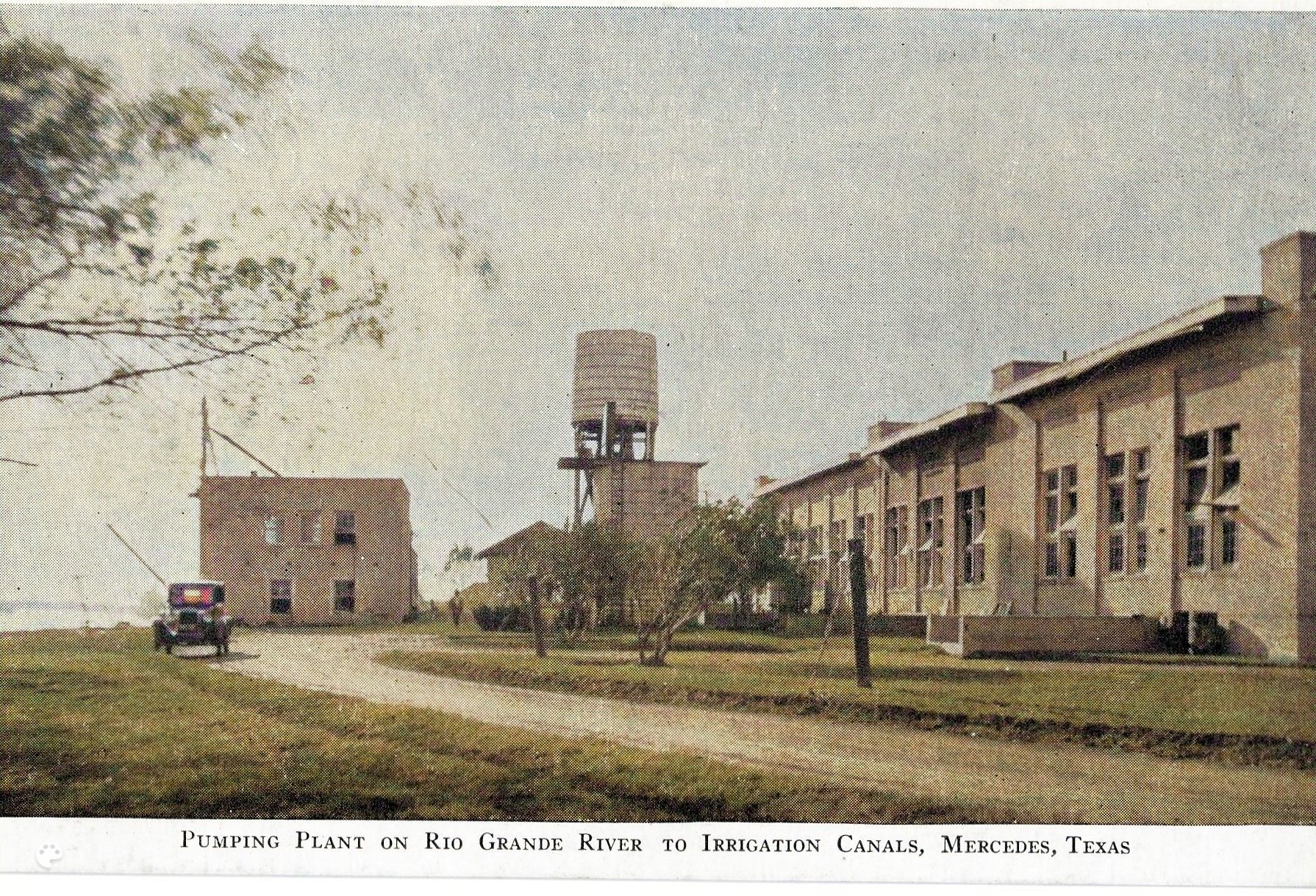 C002
Mercedes Irrigation Pump Plant. View from Road 1928
C002
Mercedes Irrigation Pump Plant. View from Road 1928
The Mercedes irrigation plant's large pumps lifted water out of the Rio Grande River. Gravity then propelled the water through the Main Canal and then on to agricultural fields. When the plant was first built in 1906, gasoline powered vehicles such as trucks and cars were not available. Materials for the plant were transported by a small railroad spur and by horses. In this photograph taken about 20 years after construction of the pump station there is a unpaved road and a car on the left.
View Enlarged
View Library
 W054
Photograph of Pumphouse in Mercedes Texas 1920
W054
Photograph of Pumphouse in Mercedes Texas 1920
The photograph is labeled Photograph of Pumphouse in Mercedes Texas. It does not appear to be the main pump plant, so it is unclear where this was located.
View Enlarged
View Library
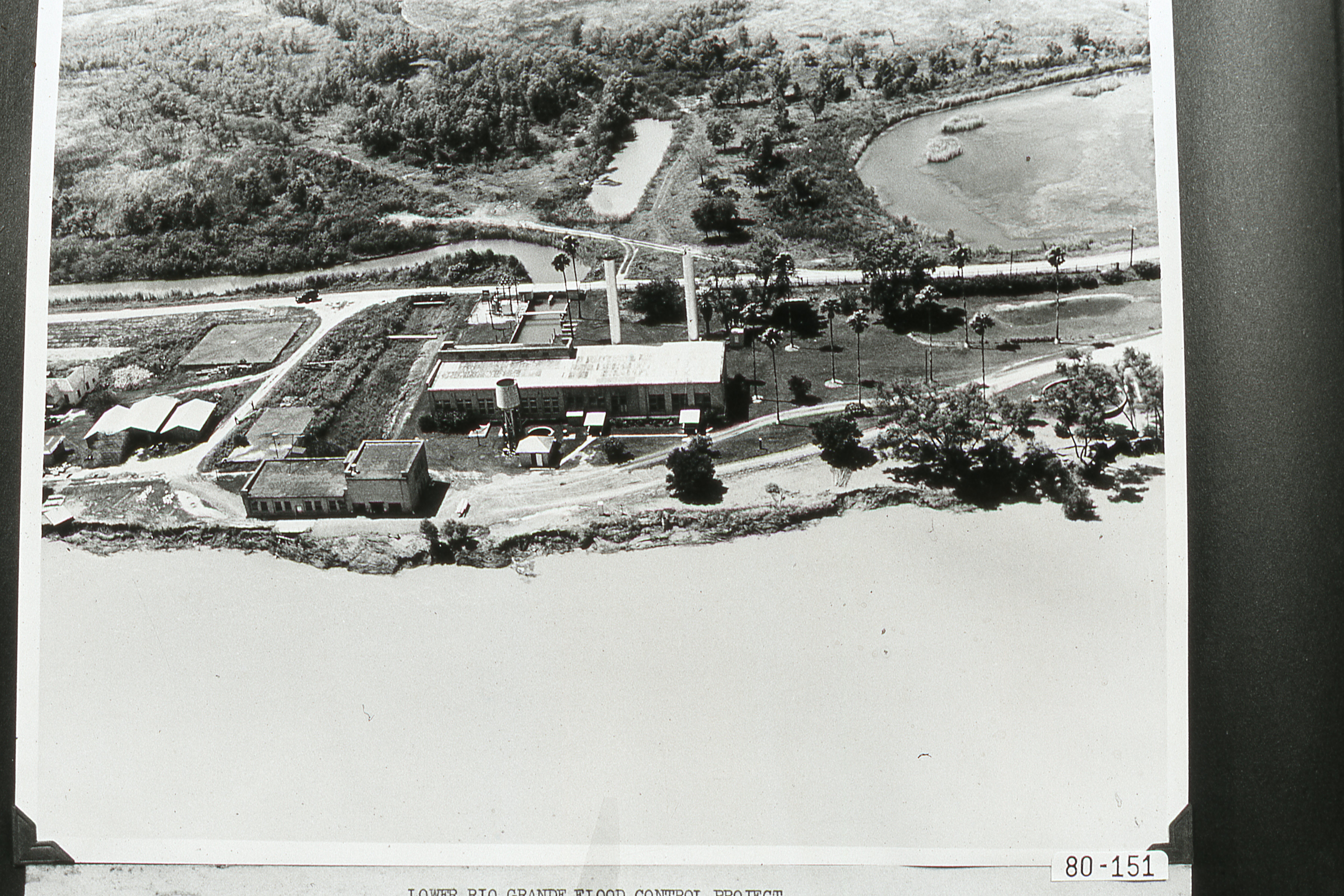 W026
Pumping plant 1941
W026
Pumping plant 1941
Looking North from the Rio Grande River, the pumphouse is in the middle if the photograph. To the left of the two smokestacks is the outlet into the main canal which diverges to the West and North. In the upper right corner is the reservior.
View Enlarged
View Library
 R012
Mercedes Canal System Was First to Use Man-Made Rock in Texas 1906
R012
Mercedes Canal System Was First to Use Man-Made Rock in Texas 1906
Flumes are enclosed structures used to carry water over ravines or floodways. This concrete flume was built to carry Mercedes Main Canal water over the Arroyo Colorado. It was the largest flume in the canal system. The American Irrigation and Land Company was the first company in Texas to utilize concrete, or man-made rock as it was called by some.[24]
View Enlarged
View Library
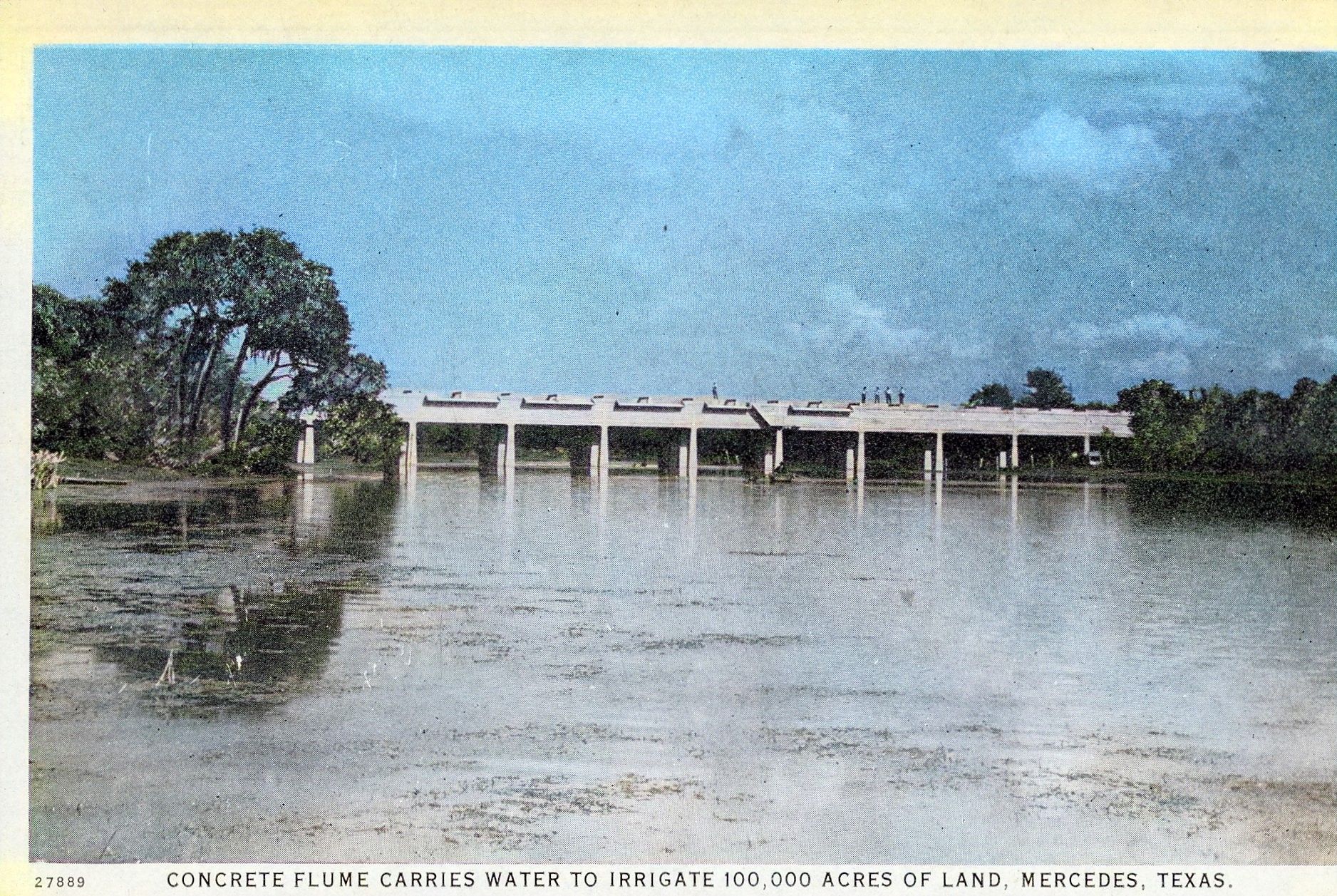 G003
Flume Channeled Mercedes Main Canal Across Arroyo Colorado 1928
G003
Flume Channeled Mercedes Main Canal Across Arroyo Colorado 1928
This postcard image is a later view of the large concrete flume that was constructed to channel the Mercedes Main Canal over the Arroyo Colorado. The floodway is full of water in this image, and the flume is visible. Look closely to see five men standing on the flume just to the right of center, and a man in a rowboat in the middle. The location of this flume, and whether it is still standing today, is unknown. It is likely that it was located over the floodway on 2nd Street, heading west out of Mercedes.
View Enlarged
View Library
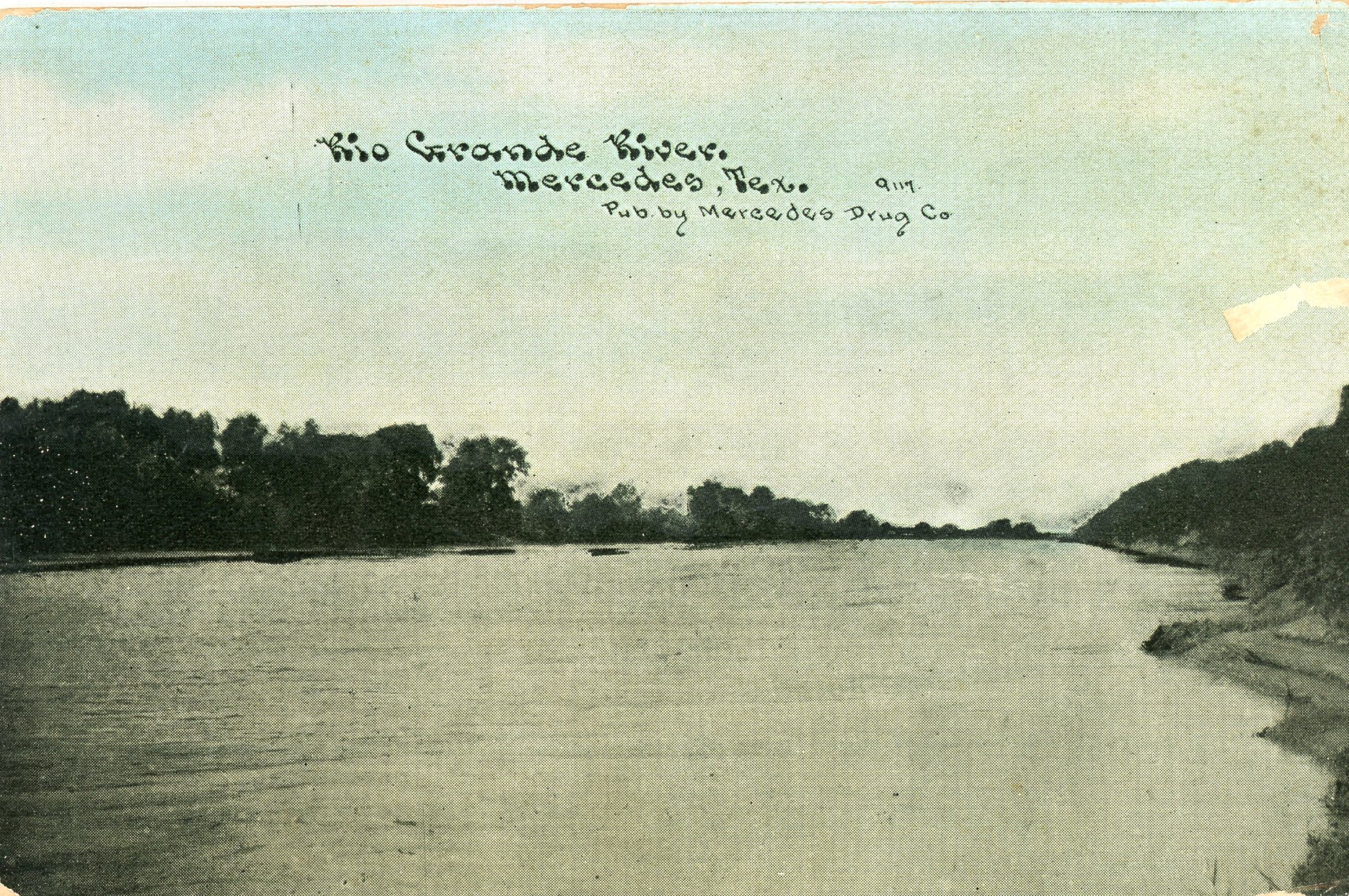 E013
Rio Grande River Was Wider and Deeper Before Irrigation 1909
E013
Rio Grande River Was Wider and Deeper Before Irrigation 1909
From the mid-1700s to the early 1900s, steamboats transported passengers and goods on the Rio Grande River. As irrigation for large-scale agricultural production increased, the river volume decreased to such an extent that steamboat transportation became impracticable. The last riverboat navigated the Rio Grande around 1909. [78]
Today more than 15 dams and diversions have reduced the river flow to a fraction of what it used to be. The Rio Grande Regional Water Authority coordinates allocation of the river waters. The agency was created by the Texas Legislature in 2003 as a conservation and reclamation district 'to serve a public use and benefit' by bringing together regional water interests to accomplish projects and services within Willacy, Cameron, Hidalgo, Starr, Zapata, and Webb counties.[24]
View Enlarged
View Library
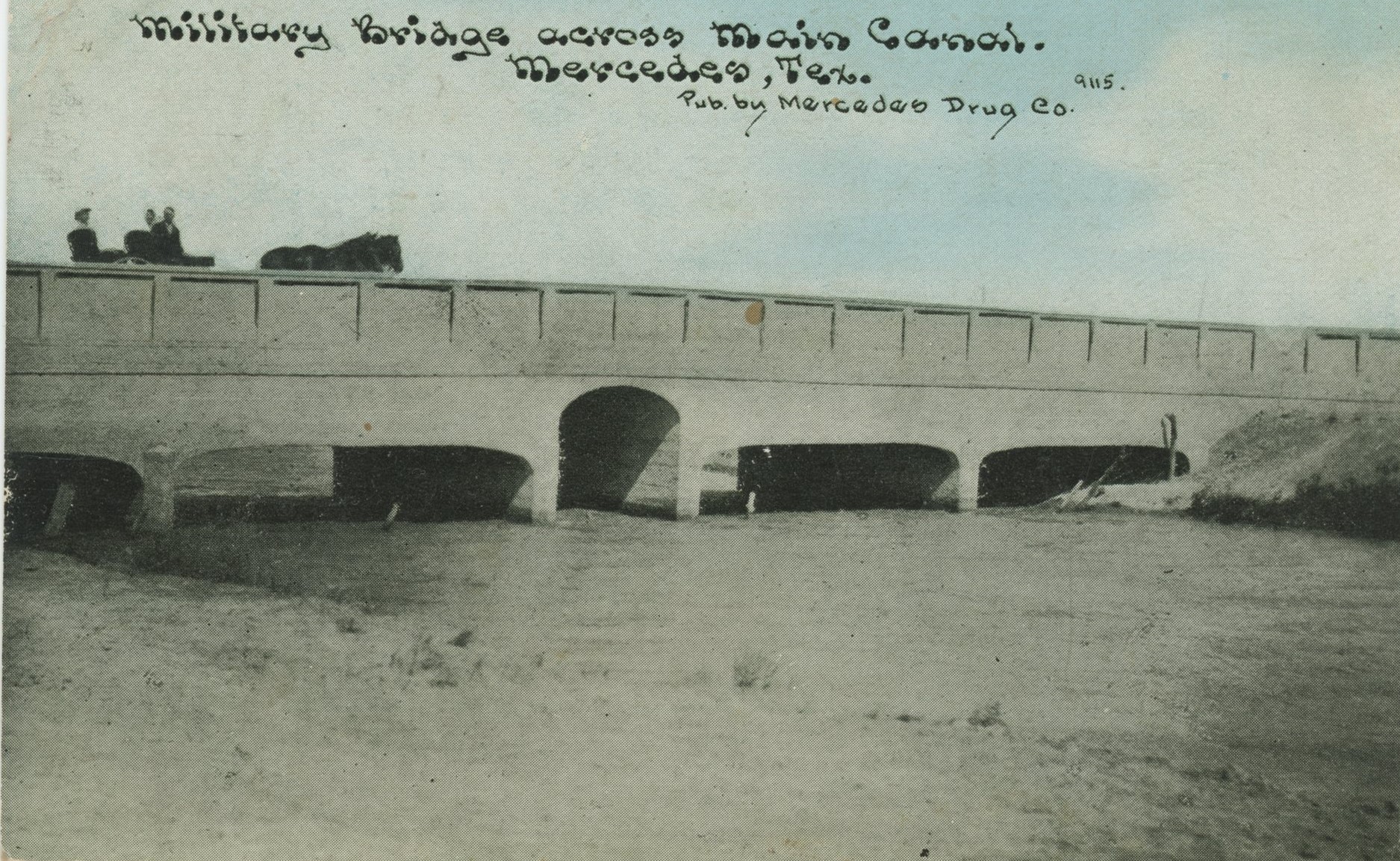 E014
Bridge on Military Highway across the Mercedes Main Canal 1909
E014
Bridge on Military Highway across the Mercedes Main Canal 1909
The American Rio Grande Land and Irrigation Company built this five-arch reinforced concrete bridge over the Mercedes Main Canal on the Military Highway in the early 1900s. It cost several thousand dollars to build, a large sum at the time. [24] Look closely to see a horse-drawn carriage with three passengers crossing the bridge.
Today, the Military Highway is part of Highway 281. The main canal has been channeled under the highway, and the bridge pictured here was demolished many years ago.
View Enlarged
View Library
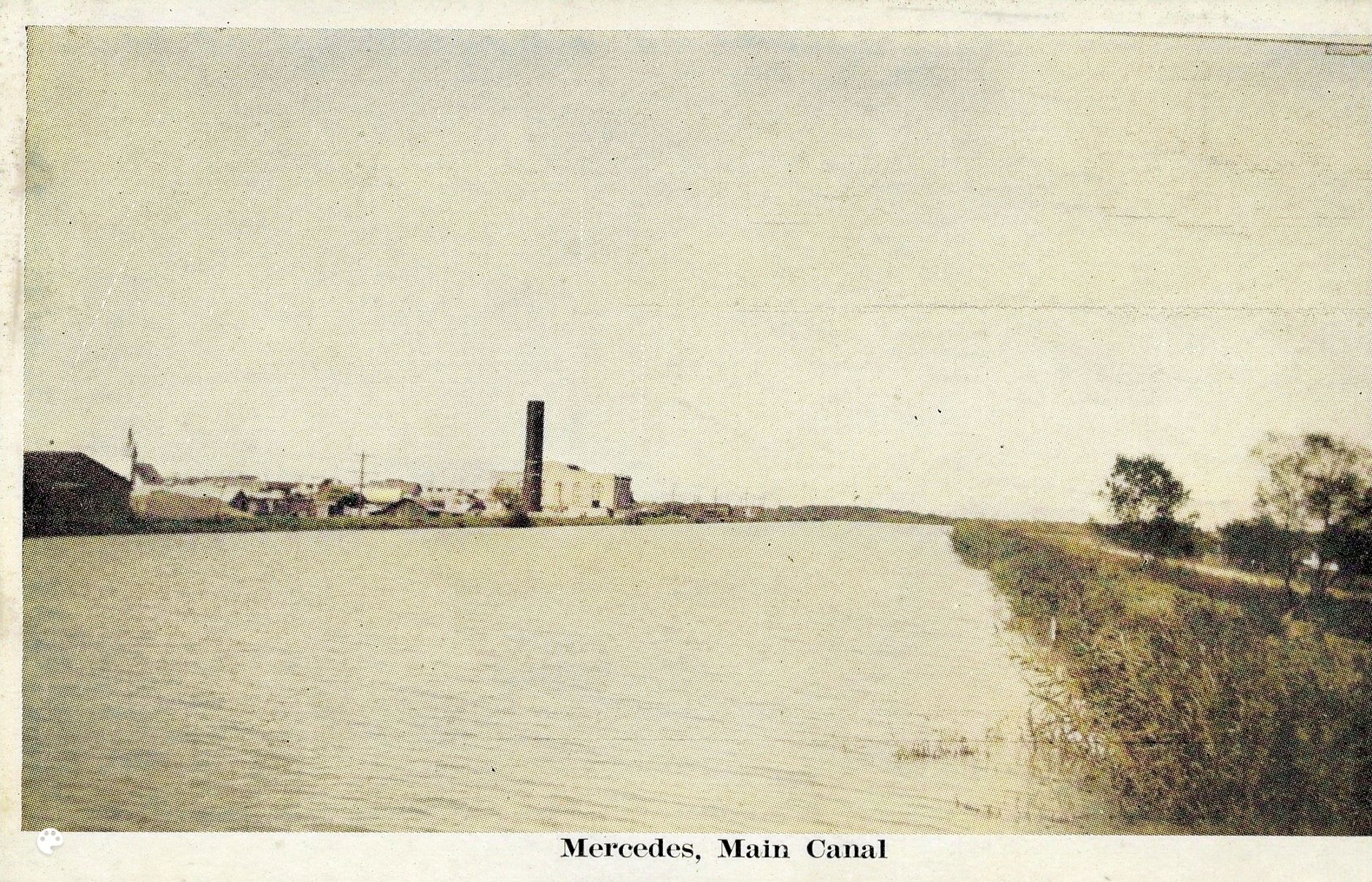 D005
Mercedes Main Canal and Electric Power Plant 1920
D005
Mercedes Main Canal and Electric Power Plant 1920
This view of the Electric Power Station with the large smokestack was taken from the East side of Mercedes Main Canal. The canal was originally dug to be 90 to 120 feet wide at some points and from 15 to 20 feet deep. The canal still provides irrigation today, more than 100 years after its construction. [24]
View Enlarged
View Library
 O002
Lining Canals with Concrete Began in Mid 1920s 1937
O002
Lining Canals with Concrete Began in Mid 1920s 1937
The American Rio Grande Land and Irrigation Company built branch canals called laterals to channel water to new fields as farmers bought additional land further from the Mercedes Main Canal. Laterals were built as needed to reach farmland as it was sold. The overall design and function of the irrigation system was inefficient because land was sold to farmers in scattered parcels wherever they wanted to buy it.
Concrete was used for many irrigation components such as pipes and drains at the beginning of the irrigation project, but canals were not fully lined with concrete until 1928. This greatly reduced water loss to seepage. Many of the original canals, both lined and unlined, are still in use today in Mercedes and the surrounding area.[24]
View Enlarged
View Library





















